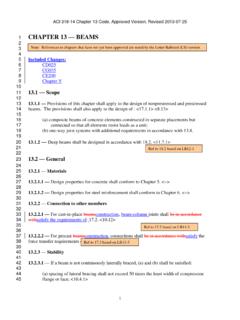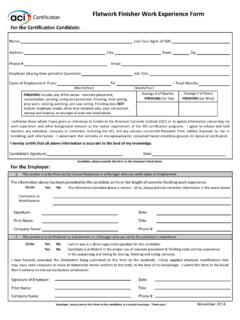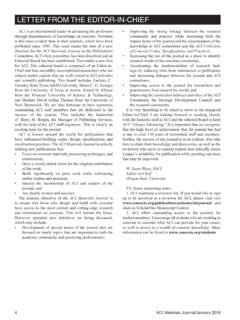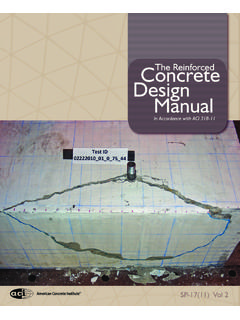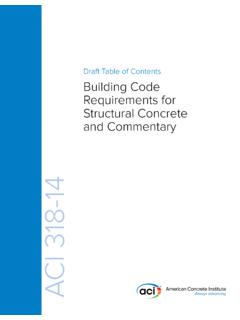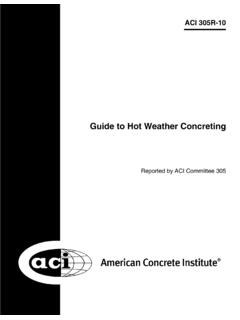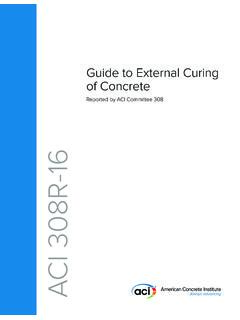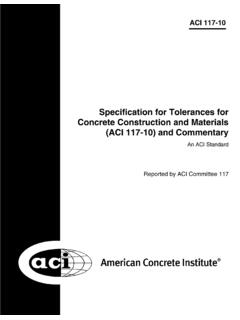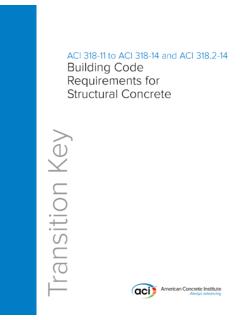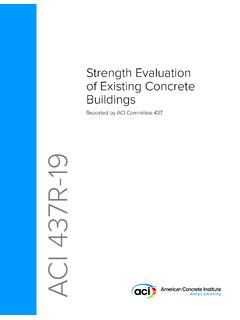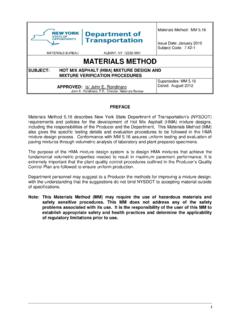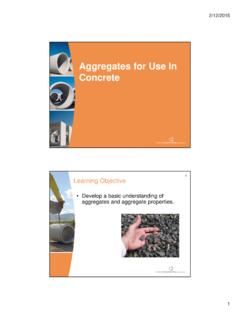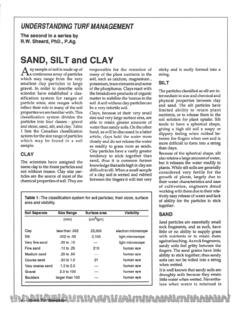Transcription of ACI MANUAL OF CONCRETE INSPECTION
1 ACI MANUAL OF. CONCRETE . INSPECTION . Reported by ACI Committee 311. SP-2(07). Tenth Edition Copyright 2007, American CONCRETE Institute First printing, March 2008. Second printing, March 2009. ISBN: 978-0-87031-275-5. ACKNOWLEDGMENTS. This MANUAL is based on information from many sources, organizations, and individuals whose contributions are gratefully acknowledged. Published references are listed at the end of the text. References to standard specifications and methods of testing are listed separately. The original manuscript was prepared by Joe W. Kelly, Chair of ACI Committee 311, and revised over a period of years to achieve a first edition in 1941.
2 The second edition, also in 1941, included a number of corrections and minor revisions. The third edition, in 1955, incorporated many constructive suggestions from users. The fourth edition, in 1957, brought several sections up to date and contained editorial corrections. The fifth edition provided new information on settlement of CONCRETE , shoring and forming, strength requirements, cold-weather concreting, and shotcrete. The sixth edition primarily provided updated information in all chapters, and included editorial and substantive changes throughout. The seventh edition presented a complete revision of the MANUAL by eliminating sections of the previous edition covering CONCRETE methods no longer in use.
3 Chapters 2, 11, 12, 13, 14, 15 (partial), 16, 17, and 18 covered material that was included in the MANUAL for the first time. The eighth and ninth editions were revised to reflect changes in technology and construction practices. This tenth edition presents an extensive revision and update to the text along with new photos, charts, and forms. The committee wishes to thank Anne Balogh for her extensive work in redrafting and unifying the previous text in preparation for this edition. Additionally, the committee wishes to express its thanks to Portland Cement Association (PCA) for generously providing many of the new photos contained in the MANUAL and to committee member Michelle L.
4 Wilson who organized and coordinated the selection of photos and graphics throughout the document. Finally, the committee wishes to thank Chair George R. Wargo for his efforts in coordinating the work of all contributors. ACI (ACI SP-2(07)). ACI MANUAL of CONCRETE INSPECTION Reported by ACI Committee 311. George R. Wargo Michael T. Russell Chair Secretary Gordon A. Anderson John V. Gruber Vankatesh S. Iyer Woodward L. Vogt Joseph F. Artuso Jimmie D. Hannaman, Jr. Claude E. Jaycox Bertold E. Weinberg Mario R. Diaz Robert L. Henry Robert S. Jenkins Michelle L. Wilson Donald E. Dixon Charles J.
5 Hookham Roger D. Tate Roger E. Wilson PREFACE emphasis of the MANUAL is on the technical aspects of INSPECTION and This MANUAL is intended to guide, assist, and instruct CONCRETE inspectors construction. For further information about construction practices, readers and others engaged in CONCRETE construction and testing, including field are encouraged to refer to the ACI MANUAL of CONCRETE Practice. engineers, construction superintendents, supervisors, laboratory and field Because the content of this MANUAL is general and broad in nature, no technicians, and workers. Designers may also find the MANUAL to be a valuable part of the MANUAL should be included by reference in contract documents.
6 Reference by using the information to better adapt their designs to the realities Applicable INSPECTION requirements for each project should be determined of field construction. Because of the diverse possible uses of the MANUAL and included in the specifications. and the varied backgrounds of the readers, it includes the reasoning behind the technical instructions. Chapter 1 INSPECTION and the inspector, p. 6. The field of CONCRETE construction has expanded dramatically over the INSPECTION processes years to reflect the many advances that have taken place in the CONCRETE industry. Although many of the fundamentals presented in previous editions Why INSPECTION is needed of this MANUAL remain relevant and technically correct, this tenth edition Purposes of INSPECTION incorporates new material to address these advances in technology.
7 A list Owner and contractor inspections of only a few of the recent developments in materials, equipment, and Inspector processes includes: Duties Shrinkage-compensating cement;. Increased use of supplementary cementitious materials (SCMs);. Education and certification Polymer-modified mixtures; Authority Self-consolidating concretes; Relations with contractors, supervisors, and workers New and refined admixtures; Safety Fiber-reinforced CONCRETE ; Importance of clear specifications Epoxy resins;. High-capacity and automated CONCRETE production equipment;. High-performance and high-strength CONCRETE ; and Chapter 2 Statistical concepts for quality Epoxy-coated and stainless steel-clad reinforcement.
8 Assurance, p. 10. The need to cover new issues affecting INSPECTION is the reason ACI Quality-control and quality-acceptance inspections Committee 311 continues to revise the ACI MANUAL of CONCRETE INSPECTION . Traditional quality assurance In preparing this edition of the MANUAL , as with previous editions, the Statistical concepts and procedures committee's task was to interpret the policies set forth by other authorized Basic statistical concepts bodies rather than to make policy on construction practices. The main Definitions Normal distribution curves ACI Committee Reports, Guides, Manuals, Standard Applying normal distribution curves to CONCRETE Practices, and Commentaries are intended for guidance in planning, designing, executing, and inspecting construction.
9 Compressive strength This document is intended for the use of individuals who are Statistical tools competent to evaluate the significance and limitations of its Frequency distributions content and recommendations and who will accept responsibility for the application of the material it contains. Control charts The American CONCRETE Institute disclaims any and all responsibility for the stated principles. The Institute shall not be liable for any loss or damage arising therefrom. ACI supersedes ACI and was adopted December 2007 and Reference to this document shall not be made in contract published March 2008.
10 Documents. If items found in this document are desired by the Copyright 2007, American CONCRETE Institute. Architect/Engineer to be a part of the contract documents, they All rights reserved including rights of reproduction and use in any form or by any means, including the making of copies by any photo process, or by electronic or shall be restated in mandatory language for incorporation by mechanical device, printed, written, or oral, or recording for sound or visual reproduction the Architect/Engineer. or for use in any knowledge or retrieval system or device, unless permission in writing is obtained from the copyright proprietors.
